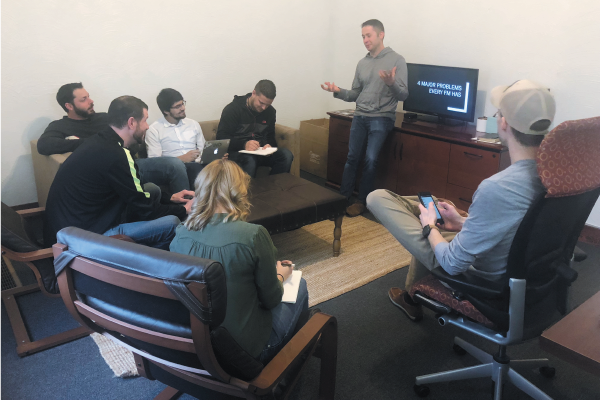Community partnerships, training programs and career paths all part of the solution
There is a gap between the skills needed by members of the retail facilities management industry and the skills available in today’s emerging workforce. The gap, however, is not limited to retail FM – which exacerbates the challenge as FMs and their suppliers look for employees with trade, technology and management skills.
In fact, FMs are competing with manufacturing, construction and landscaping industries for talented individuals who can see career opportunities in jobs that may not be typically identified on a student’s wish list for jobs after graduation.
The reasons for the decline in skilled trades such as carpentry, electrical, plumbing and HVAC are varied, but the emphasis on college educations and careers focused on professional or white-collar jobs for young people is one reason. A slowdown in construction during the recession created a surplus of skilled trade workers who moved into other jobs and did not return when the construction industry began its recovery. For some retail FMs, the construction slowdown helped fill trade jobs in the retail industry, but these employees are closer to retirement, with no young, experienced people in the pipeline.
The gap was identified by members of the Society for Human Resource Management (SHRM) in a 2014 survey in which respondents identified the jobs for which they had the most difficulty recruiting. High-skilled technicians were identified by 65 percent and skilled trades were reported by 63 percent as difficult to recruit.1
More recently, 43 percent of PRSM’s supplier members responding to the 2017 member survey reported that hiring and retraining qualified trade professionals (43 percent) is one of their biggest challenges.2
The skills gap is not just related to trades. As FM departments become more technologically dependent on software, mobile apps, energy programs and integrated management systems, the ability to balance technology skills with people skills to ensure good customer service becomes critical.
A 2016 study conducted by SHRM reports that more than half of HR professionals reported some level of basic skills/knowledge deficits among job applicants and 84 percent reported applied skills shortages in job applicants in the last year.3
The most often identified basic skills shortage were writing in English, basic computer skills, spoken English language, reading comprehension and mathematics. The most commonly reported applied skills missing include critical thinking/problem-solving, professionalism/work ethic, leadership, written communications and teamwork/collaboration.
Although HR professionals admitted they were adjusting recruitment strategies to reach qualified candidates through social media, they also identified training existing employees to take on hard-to-fill roles and supporting them in their development of needed skills to fill the gaps as the most important strategy an organization can adopt.
Preparing employees to take on other roles such as moving from field tech to customer service representative in an FM department, supervising a skilled trade group, or managing a sourcing group, ensures retention of quality, experienced employees.
The opportunity to move up in an organization is important – in fact, 82 percent of respondents to the PRSM Retail Member Survey say that one of the challenges they face is difficulty finding a position that allows for career advancement and promotion.4 Because it costs less to train and keep employees, than to recruit, train and lose employees, companies that offer ongoing education and pathways for advancement have an edge on their competitors. Not only does this strategy differentiate an employee in the employee recruitment marketplace, but it also establishes a continuity retail organizations and clients appreciate.
Flexibility in the workplace is another way organizations can retain older workers. More members of the Baby Boomer generation are interested in working beyond traditional retirement age. A number of different strategies were reported by HR managers in a SHRM report on the aging workforce5:
• 48 percent offered reduced hours or part-time positions to older workers
• 40 percent hired retired employees as consultants or temporary workers
• 37 percent started flexible scheduling that included telework and alternative work schedules
• 30 percent created or redesigned positions that allow bridged employment – enabling employees to ease into retirement while the company retains good employees to train upcoming replacements
• 29 percent provided training to upgrade skills of older workers
• 27 percent provided opportunities for older workers to transfer to jobs with reduced pay and responsibility
• 24 percent increased training and cross-training to induce older workers to stay with or join the company
An often-overlooked potential employee pool are military veterans. Training they received while in service might cover a variety of skilled trades or information technology. Applied skills such as problem-solving, leadership and work ethic are all part of military training as well. Matching their experience and skills to the organization’s needs is another option to address job openings and skill gaps.
Even if FM managers can retain older, experienced employees, or fill openings with former military veterans, the need to strengthen the pipeline of FM employees for the future is critical. According to the Bureau of Labor, trade jobs account for 54 percent of the labor market but only 43 percent of the country’s workers are trained in the trades.6
Grassroots efforts by industry representatives can offset the negative impression or lack of awareness of career opportunities in trade skills through partnerships with vocational-technical schools as well as efforts to reach high school students. Summer internships, mentorships, sponsorship of school clubs, participation in school community events and even summer job opportunities give FMs an opportunity to further educate students, their parents and school counselors about career opportunities.
Students who like to build and create are the ideal audience for trade schools or apprentice programs. Unfortunately, most parents and high school counselors steer students to college, even if it may not be the best route for them. Skilled trades are often only recommended to students whose counselors do not believe have the academic potential for college.
In addition to promoting the employment opportunity that exists due to the gap between demand for and availability of tradespeople, young people have an opportunity to start a well-paying job with less time in school – two years or less compared to four years. A vocational-technical education is also less costly with little or no school debt depending on the program of study.
The skills gap challenge faced by FMs today won’t disappear quickly. However, experts say that thoughtful, strategic planning can address the need to strengthen the new employee pipeline, create partnerships that develop new employees and establish training programs that help recruit, develop and retain quality workers.
References:
1. 2014 Economic Conditions—Recruiting and Skills Gaps (SHRM, 2014)
2. 2017 Supplier Member Survey (PRSM, 2017)
3. The New Talent Landscape (SHRM, 2016)
4. 2017 Retailer Member Survey (PRSM, 2017)
5. Preparing for an Aging Workforce (SHRM, 2016)
6. NSC Analysis of Bureau of Labor Statistics Occupational Employment Statistics by State (2015), and American Community Survey Data (2015)
Most difficulty recruiting for:
High-skilled technicians:
65 percent
Skilled
trades:
63 percent
Source: 2014 Society for Human Resource Management (SHRM) survey
43%
Job Openings
Hiring and retraining of
qualified trade professionals
(43 percent) is one of PRSM members’ biggest challenges.
Source: 2017 PRSM Member Survey
Flexibility with aging employees
48% offered reduced hours or part-time positions to older workers
40% hired retired employees as consultants or temporary workers
37% started flexible scheduling that included telework and alternative work schedules
30% created or redesigned positions that allow bridged employment – enabling employees to ease into retirement
while the company retains good employees to train upcoming replacements
29% provided training to upgrade skills of older workers
27% provided opportunities for older workers to transfer to jobs with reduced pay and responsibility
24% increased training and cross-training to induce older workers to stay with or join the company
Source: Preparing for an Aging Workforce (SHRM, 2016)
Over 50 percent of HR professionals reported some basic skills/knowledge deficits among job applicants.
84 percent reported applied skills shortages in job applicants in the last year.
Source: 2016 SHRM study
By: Sheryl S. Jackson









.jpg)
